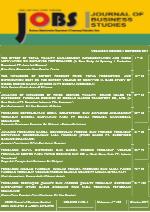ANALYSIS OF QUALITY IMPROVEMENT USING STATISTICAL PRPOCESS CONTROL TOOLS TO REDUCE THE DEFECT LEVEL OF GREY FABRIC PRODUCT (A CASE STUDY AT PT SARI WARNA ASLI II BOYOLALI)
DOI:
https://doi.org/10.32497/jobs.v2i2.667Abstract
This study aims to find out the implementation of quality control of products at PT Sari WarnaAsli II Boyolali by using statistical methods, to identify the type of dominant product defects and to identify the factors that resulted in product defect including Light Filling Bar, Miss Pick, and Filling Bar. The method of collecting data are interview, observation, and literature review. Analysis of quality control is done by using Statistical Process Control tools such as check sheet, histogram, c chart, pareto chart, and fishbone chart. Check sheet and histogram are used to present data become easier to be understood for further analysis. C chart analysis result indicate that there are 27 days in March 2016 in which the data is out of control limits, it means that quality control in the company needs further improvement. According to pareto analysis, the dominant of defects are Light Filling Bar (45,3%), Miss Pick (28,8%), and Filling Bar (25,9%). From fishbone chart, it can be known that the main causes that trigger the defects are derived from method factor, personnel (man) factor, and machine factor. The company could take preventive and corrective measures to reduce the defect level and improve quality among others, by enhancing supervision, improving work assessment, and regenerating machines.Downloads
Published
Issue
Section
License
Authors who publish with this journal agree to the following terms:
Authors retain copyright and grant the journal right of first publication with the work simultaneously licensed under a Creative Commons Attribution License that allows others to share the work with an acknowledgement of the work's authorship and initial publication in this journal.
Authors are able to enter into separate, additional contractual arrangements for the non-exclusive distribution of the journal's published version of the work (e.g., post it to an institutional repository or publish it in a book), with an acknowledgement of its initial publication in this journal.
Authors are permitted and encouraged to post their work online (e.g., in institutional repositories or on their website) prior to and during the submission process, as it can lead to productive exchanges, as well as earlier and greater citation of published work (See The Effect of Open Access).






